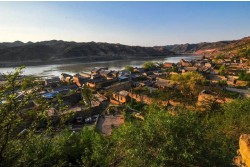

Introducing Qikou Ancient Town
from ancient-origins.net
The word ‘Qi’ in the town’s name has been translated to mean ‘sand-piled shoal’. This phenomenon occurs when sudden fluctuations in the Yellow River (which the town is situated on the east bank of) cause rip currents to occur. As a result, the river becomes much shallower during this time. In one report, it is stated that the depth of the river could “reduce from 400 (1312.34 ft.) meters to 80 (262.467 ft.) meters”. Thus, the town of Qikou was named after this natural phenomenon.
Due to its geographical location, the land around the town is not suitable for agricultural activities. The Yellow River, however, was an important route for the transportation of trade goods in ancient times. It was due to this that Qikou prospered. From Qikou, goods were transported to “Lanzhou and Wuzhou [in the] west, Baotou and Wuyuan [in the] north, Handan and Zhengzhou [in the] south, and Taiyuan, Beijing [and] Tianjin [in the] East.”
The town of Qikou thrived during the Ming and the Qing Dynasties. During these periods, it “served as a vital trading point marking the eastern terminus for river-bound freight between northwest and north China.” At this point, the Yellow River became narrower and shallower, thus making it difficult, if not impossible, for boats journeying to the east and north to pass. Thus, the trade goods had to continue their journey overland in caravans of horses or camels. This brought business for the people of Qikou, and made the town flourish.
The remnants of this past glory can be seen in the town’s many well-preserved buildings. During its heyday, Qikou is reputed to have had more than 380 shops operating in the town. These shops were likely to have catered to the needs of the passing merchants, providing them with a variety of goods and services.
One of the buildings in the town that attests to this, for example, is a shop that housed an escort agency called Shi Yi Biao Ju’, roughly translate as ‘Ten Righteousness Escort Agency’). Such agencies hired out caravan guards to merchants who wanted extra protection for their goods.
Qikou’s prosperity gradually declined during the first half of the 20th century. During the 1930s, rail transport was introduced into the region. Still, Qikou remained as a trade center connecting business from Shanxi, Shaanxi, and Inner Mongolia until the 1940s. Since then, the use of modern transportation meant that Qikou lost its role as a trade hub.
Due to the economic decline of Qikou, many young people left the town for larger cities since the 1980s. Additionally, this decline has helped to preserve the old buildings from being redeveloped into new structures. In the past two decades, efforts have been made by the local government to inject new life into the town by bringing in the tourism industry.
The town’s well-preserved structures and its scenic landscape are promoted as its greatest attractions. Whilst this industry would re-invigorate this sleepy town, it has also been warned that there are potential hazards, such as the “threats of superhighway access to Qikou and a proposed riverfront highway that would sever its historic access to the waterfront.” Therefore, it is important that a balance is struck between tourism and the preservation of the town.
Qikou Ancient Town Fast Facts
• Chinese Name: Qi Kou Zhen 碛口镇
• Best Time to Visit: April to Oct
• Recommended Visiting Hours: 2 -3 hours
• Type: Folk dwellings
• Opening Hours: 24 hours
• Entrance Fee: free
• Address: Qikou, Lin County, Shanxi.
How to get to Qikou Ancient Town
• Qikou Ancient Town is approximately 250km away from Taiyuan.
• Rent a car/bus from GGC to enjoy a hassle free private transfer from hotels in Taiyuan to Qikou Ancient Town.